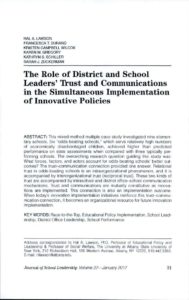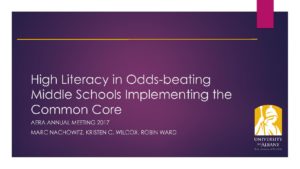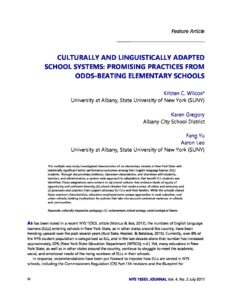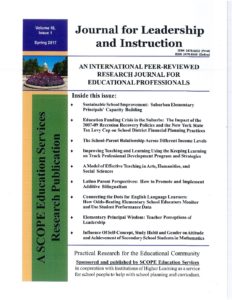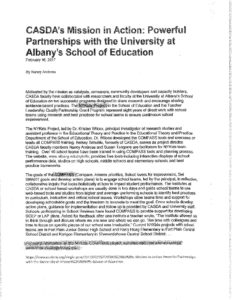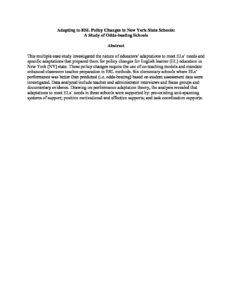Publication Year: 2017
This mixed-method multiple case study investigated nine elementary schools. Six “odds-beating schools,” which serve relatively high numbers of economically disadvantaged children, achieved higher than predicted performance on state assessment when compared with three typically performing schools.
This mixed-method multiple case study investigated nine elementary schools. Six “odds-beating schools,” which serve relatively high numbers of economically disadvantaged children, achieved higher than predicted performance on state assessments when compared with three typically performing schools. The overarching research question guiding this study was: What forces, factors, and actors account for odds-beating schools’ better outcomes? The trust-communication connection provided one answer. Relational trust in odds-beating schools is an intraorganizational phenomenon, and it is accompanied by interorganizational trust (reciprocal trust). These two kinds of trust are accompanied by intraschool and district office-school communication mechanisms. Trust and communications are mutually constitutive as innovations are implemented. This connection is also an implementation outcome. When today’s innovation implementation initiatives reinforce this trust-communication connection, it becomes an organizational resource for future innovation implementation.
Literacy practices among “odds-beating” middle schools implementing the Common Core.
Literacy practices among “odds-beating” middle schools implementing the Common Core. The presentation explores the ways that teachers’ literacy instruction practices, in the context of attempting to align to the Common Core Learning Standards, show evidence of attention to developing high literacy.
Multiple case study investigated characteristic of six elementary schools in New York State with statistically significant better performance outcomes among their English language learners (ELL) students. Through documentary evidence, classroom observations, and interviews with students, teachers, and administrators, a system-wide approach to adaptations that benefit ELL students was identified.
This multiple case study investigated characteristics of six elementary schools in New York State with statistically significant better performance outcomes among their English language learner (ELL) students. Through documentary evidence, classroom observations, and interviews with students, teachers, and administrators, a system-wide approach to adaptations that benefit ELL students was identified. These adaptations were evident in: (a) school cultures that embrace ideals of equity of opportunity and celebrate diversity; (b) school climates that evoke a sense of safety and welcome; and (c) processes and practices that support advocacy for ELLs and their families. While the schools shared these common characteristics, educators employed some unique approaches in rural, suburban, and urban schools, holding implications for policies that take into account contextual variances in schools and communities.
Findings from a multiple case study investigating the nature of educators’ approaches toward monitoring English language learners (ELLs) performance and using data to improve instruction and apply appropriate interventions.
This article reports on findings from a multiple case study investigating the nature of educators’ approaches toward monitoring English language learners’ (ELL) performance and using data to improve instruction and apply appropriate interventions. Six New York elementary schools where ELLs’ performance was better than predicted (i.e. odds-beating) based on student assessment data were studied. The analysis revealed that several strategies were common among the schools studied and were associated with the schools’ better ELL performance outcomes. These include: (1) connecting instruction and interventions to “real time” data based on multiple measures of student performance including benchmark and formative assessments; (2) communicating performance via technology among teachers and with family members and legal guardians; (3) collaborating through routines among teaching and support staff as well as school and district leaders. Implications for district and school leaders and teachers are discussed. Implications for district and school leaders as well as teachers and other instructional specialists are offered.
The goals of the COMPASS (Compare, Assess priorities, Select levers for improvement, Set SMART goals and develop action plans) is to engage school teams, led by the principal. In reflective, collaborative inquiry that looks holistically at how to impact student performance.
Motivated by the mission as catalysts, conveners, community developers and capacity builders, CASDA faculty have collaborated with researchers and faculty at the University at Albany’s School of Education on two successful programs designed to share research and encourage sharing evidence-based practices. The NYKids Project in the School of Education and the Teacher Leadership Quality Partnership Grant Program represent eight years of direct work with school teams using research and best practices for school teams to ensure continuous school improvement.
The goals of the COMPASS (Compare, Assess priorities, Select levers for improvement, Set SMART goals and develop action plans) is to engage school teams, led by the principal. In reflective, collaborative inquiry that looks holistically at how to impact student performance.
School improvement practices to support youth experiencing poverty.
School improvement practices to support youth experiencing poverty. The presentation explores how teacher describe their experiences implementing the Common Core State Standards, with Annual Professional Performance Review system, and supports for their adjustments to the Common Core, Annual Professional Performance, and Data-Driven Instruction innovations.
Multiple case study investigating the nature of educators’ adaptations to meet ELs’ needs and specific adaptations that prepared them for policy changes for English learner (EL) education in New York (NY) state.
Multiple case study investigating the nature of educators’ adaptations to meet Els’ needs and specific adaptations that prepared them for policy changes for English learner (EL) education in New York (NY) state. These policy changes require the use of co-teaching models and mandate enhanced classroom teacher preparation in ESL methods.

